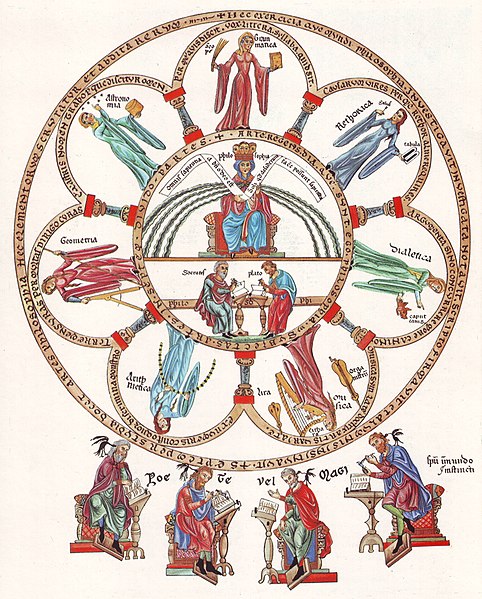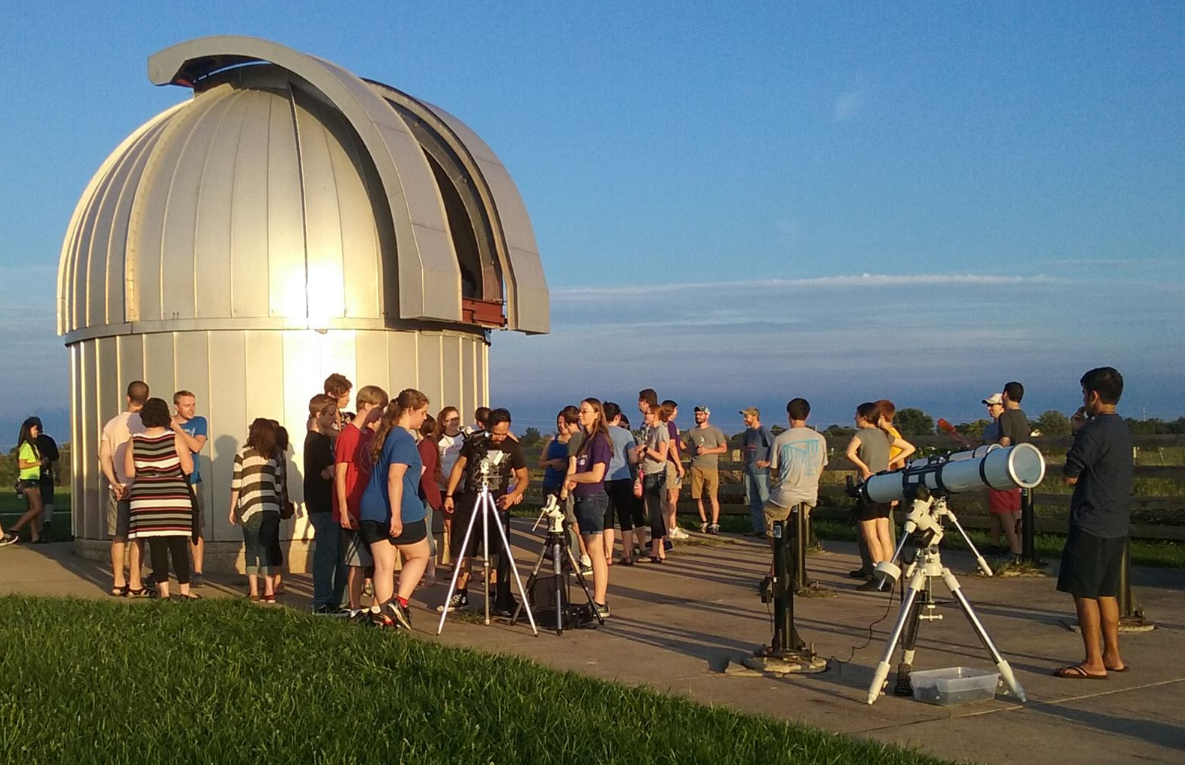Rationale
A liberal arts education consists of four types of skills (or arts): Arithmetic & geometry, Music, and Astronomy. Astronomy was once considered an essential skill — it had applications in navigation, predicting weather, and the seasons. Most ancient cultures, including indigenous peoples in the Americas, across the continents have myths and folklore associated with the stars and constellations in the sky. In the Western tradition, which follows from ancient Greek and Hellenistic traditions, these four “Quadrivium” skills (arithmetic, geometry, music and astronomy) together with the more fundamental “Trivium” skills (rhetoric, grammar, and logic) were essential for a truly liberated (free) person to participate in civic life.
Following this rich tradition and our mission statement to “urge all students to make themselves productive, free and equal“, the astronomy minor at Truman State provides students from all majors and backgrounds with the opportunity to explore one of the oldest natural sciences in a meaningful and fulfilling way. This is an exciting time to study astronomy: we are discovering Exoplanets at an increasing rate, and have already discovered “earth-like” planets in the habitable zones of Sun-like stars. Gravitational waves are detecting massive black holes. The James Webb Space Telescope will help us answer many questions regarding the shape, size and complexion of our Universe, and may be even detect signs of life elsewhere in the Galaxy! Many of these discoveries will alter our self-image as human beings and put into perspective our place in the Universe.

Philosophia et septem artes liberales, the seven liberal arts. From the Hortus deliciarum of Herrad of Landsberg
Picture Credit: Wikimedia Commons
Our course offerings are designed towards providing the student with tools to appreciate some of these profound questions (“What is the nature of our Universe?”, “What is life?”, “How did the Sun and other stars form?”, “How did the Earth form?”, “Is there life elsewhere in the Universe?”, and so on) and learn about ways in which scientists are attempting to address these questions. Students will have the opportunity to learn technical skills needed in almost all fields of life (math skills like proportionality, trigonometry, basic algebra, logarithms, plotting graphs, and so on), but more importantly, students will develop a scientific mindset that will help them navigate through the increasing problem of misinformation and pseudo-science that is permeating our culture.
We believe that our students should not only learn course content, but also develop as people and citizens through engagement in all types of university activities. The content of this minor will make students introspect and question their position and role in our Universe. To engage in the ‘big questions’ like the ones mentioned above requires one to explore ones identity and appreciate ambiguity. This forces our students to take intellectual risks in search of the ‘truth’ and to broaden their horizons. Astronomy’s role in shaping our worldview can best be appreciated by dwelling on this quote from the late Carl Sagan:
“It has been said that astronomy is a humbling and character-building experience. There is perhaps no better demonstration of the folly of human conceits than this distant image of our tiny world. To me, it underscores our responsibility to deal more kindly with one another, and to preserve and cherish the pale blue dot, the only home we’ve ever known.”
Required Courses: 16-17 Credits
The Astronomy Minor requires the successful completion of 16-17 credits. Four or five of these credits come from an Introductory Physics course. Either one of Phys 185/186 (non-calculus based Physics usually taken by Exercise Science and Biology majors) or one of Phys 195/196 (calculus based Physics usually taken by Physics, Math, and Chemistry majors) will suffice. Having some basic physics background is essentially to truly appreciate the beauty and scope of astronomy!
Additionally, three Astronomy classes (12 credits) constitute the Astronomy minor. Sample syllabi are linked on the course titles:
Phys 131 (Astronomy I) covers the properties of electromagnetic radiation, properties and evolution of stars and galaxies,
Phys 132 (Astronomy II) covers basic visual astronomy (stars, constellations, planets, Moon etc. in the night sky), and the study of the Solar System (the planets, asteroids, comets, Moon, and the Sun) and extra-solar planets (planets and planetary systems around other stars).
Both Phys 131 and Phys 132 have a lab-component. Depending on weather, at least 3-5 labs will be out at the Truman Observatory. Students will learn about the prominent stars in the sky, the constellations, and how to set up telescopes and observe “deep sky objects“. Other labs will be computer based “toy simulations” that will help students connect the material covered in lecture to simulated astronomical data.
Phys 346 (Observational Astronomy) is a project based class where students engage in 3-4 projects through the semester. Typical projects include observing exoplanet transits, observing and modelling eclipsing binary stars, asteroid light curves, quantifying light pollution, and astrophotography. Students learn how to access and analyze archival data from space based missions like Kepler and TESS. Students also engage in outreach activities by learning how to plan events and operate telescopes, and take images using the eVScope.
Phys 346 can be considered a “capstone course” for the minor, since students will be called upon to use and build on the skills they have learnt in their classes and apply them to “real observational astronomy” (i.e., learn how the science of observational astronomy is practiced today).
To summarize, the astronomy minor consists of:
- Any ONE of the following classes:
-
- PHYS 185 – College Physics I Credits: 4 OR
- PHYS 195 – Physics with Calculus I Credits: 5 OR
- PHYS 186 – College Physics II Credits: 4 OR
- PHYS 196 – Physics with Calculus II Credits: 5
AND
-
- PHYS 131 – Introduction to Astronomy I Credits: 4
- PHYS 132 — Introduction to Astronomy II Credits: 4
- PHYS 346 – Observational Astronomy Credits: 4
Apart from these courses, students have the option to take more advanced Astrophysics classes: Phys 331 (Stellar Astrophysics) and Phys 332 (Galactic Astrophysics). These courses will be especially interesting to STEM majors who wish to pursue the Astro-track within the Physics major.
Facilities
The Truman State Observatory is located on the beautiful Truman farm, about 2 miles south-west of the main campus. The Observatory consists of a 17-inch Planewave CDK17 telescope, several CCD cameras used for Astronomy research, an automated dome, a weather station, a cloud sensor and a rain sensor. The observatory can be controlled remotely with the help of the ACP software package, which controls the telescope with The Sky, the CCD camera with Maximdl, and interfaces with the weather station and the cloud & rain sensors to smoothly operate the system.
In addition to the CDK17, the observatory also has two Unistellar eVScopes (see Images) that are used for outreach events.
The Observatory has several smaller 6-inch Meade reflector scopes, and one 8-inch and 10-inch Schmidt Cassegrain Meade LX 200 scopes. All these are used by students during public outreach events.

Research Opportunities
Students who wish to continue and get involved in astronomy research can work with Truman faculty that are involved in a wide range of theoretical, numerical, computational, and Observational research projects. Student funding is available through the NASA-Missouri Space Grant Consortium, through the Office of Student Research at Truman State University. Many research students have successfully applied for and been granted the TruScholar summer undergraduate scholarship and the GIASR scholarships during the Fall and Spring semesters.
-
Timothy Wiser (tdwiser@truman.edu)
- Theoretical particle physics and cosmology with applications to dark matter
- Computer simulations of dark matter behavior
- Developing inexpensive apparatus for cosmic ray particle physics
-
Colin DeGraf (cdegraf@truman.edu)
- Computer simulations – Large cosmological volumes, or zoom-in on specific targets of interest
- Galaxy formation/evolution
- Galaxy mergers
- Supermassive black holes – Formation, growth, and mergers
- Gravitational Waves
-
Vayujeet Gokhale (gokhale@truman.edu):
- Sky Brightness measurements using Sky Quality Meters, TAS photometers, and all-sky-cameras,
- Contribute to the TESS follow-up Group (TFOP) to identify eclipsing binary stars masquerading as exoplanets and,
- Asymmetries in Light Curves of Eclipsing Binary Stars.